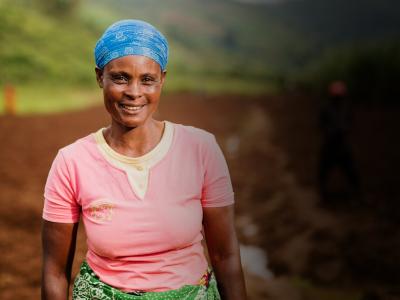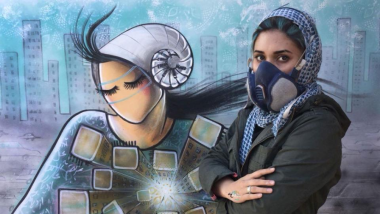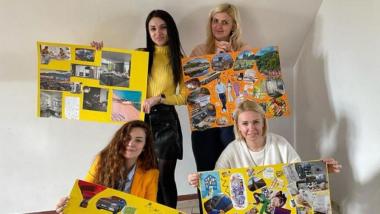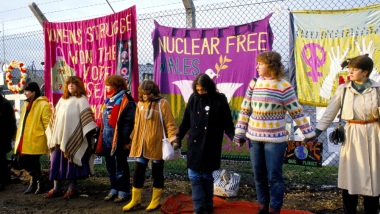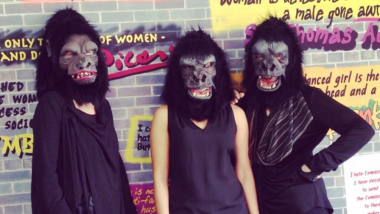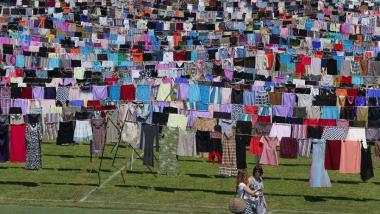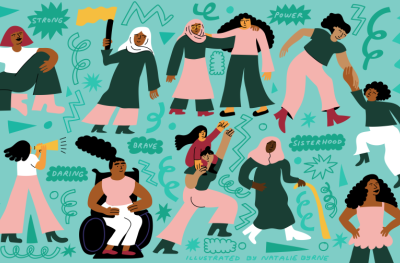Throughout history, art and activism have been closely intertwined.
Both artists and activists share an aim to convey truth, to reflect, and to question the world around them. When both disciplines are brought together, activist art has the incredible power to overcome cultural and language barriers, allowing marginalized voices to take center stage. Read this blog to learn more about the courageous women daring to use art to challenge the status quo and drive positive change in their communities.
Meet Afghanistan's First Female Graffiti and Street Artist
Before the de facto government took control of Afghanistan in 2021, Shamsia Hassani was known for decorating buildings around Kabul with her signature style and symbols for social change, empowerment and peace. Much of her work has now been erased by the de facto government, but outside of Afghanistan she continues to use her creativity and talent to send a message - that Afghan women are stronger and more powerful than they are often portrayed to be. Her work has also raised awareness about the refugee experience and ongoing restrictions that limit Afghan women’s freedoms.
Image has more effect than words and it's a friendly way to fight.
- Shamsia Hassani
Art as Therapy for Ukrainian Refugees
Kateryna Shukh is a psychologist, art therapist, project coordinator and, since 2022, a refugee. When the full-scale invasion of Ukraine took place, Kateryna was forced to flee from her home in Mariupol, Ukraine and began to rebuild her life in Poland.
Since then, she has been supporting other Ukrainian women to come to terms with their loss and trauma. Art therapy gives women an outlet to express their feelings, connect with one another, and create something beautiful – a powerful act that represents their resilience in the face of the destruction of war.
We think of war as something that happens to other people until it happens to you.
- Kateryna Shukh
In one session, women create a collage based on what they want their lives to look like in the next five years, an important step to help women reimagine their future after their plans, goals and dreams were shattered by war.
Through our Conflict Response Fund, we are working with Kateryna and her organization, Bereginja Mariupol’s Women’s Association, to provide urgent support to Ukrainian women refugees.
Crafting Peace at Greenham Common
Between 1981-1991 a group of women held a protest at Greenham Common, Berkshire, motivated by a decision by NATO to allow US cruise missiles to be stored at the local airbase.
Soon, crafting became an identifiable characteristic of the protest, a peaceful way for the Greenham Common protestors to draw attention to their cause and demonstrate their unity with one another.
It is difficult for many women to learn that they can change things on their own, without men, and that is why they feel helpless in the nuclear crisis. We have all changed since we came here.
- Sara, Greenham Peace Camp
In 1982, women were invited to craft an object to attach to the fence, which soon became a rich tapestry representing their lives, communities and everything that nuclear armament put at risk.
Between 1989 and 1991, all missiles were removed from Greenham Common.
The Guerrilla Girls Fight Back
The Guerrilla Girls are an anonymous group of artists and activists who use their creativity to fight discrimination and expose gender and racial bias in art, politics and pop culture. Growing tired of women artists being sidelined by museums and galleries, they began drawing attention to the over-representation of women’s bodies in nude art and the underrepresentation of female artists' work in exhibitions.
How can you really tell the story of a culture when you don’t include all the voices within the culture? Otherwise, it's just the history and the story of power.
- Kahlo, The Guerrilla Girls
Ready to combat the assumption that women’s bodies belonged on display, but their talent and creativity did not, the Guerrilla Girls donned their signature Gorilla masks and began creating protest art, calling for gender and racial equality. Over the years, they’ve even been invited to exhibit their work at many of the institutions they called out for bias, showing the true impact of their work.
Sending Messages of Solidarity
During the Kosovo War, sexual violence and the abuse of women’s bodies became a horrific and all too common weapon for warring parties. As a result of their trauma and societal stigma, many women felt unable to speak about their experiences, even years after the war had ended. That was until artist Alketa Xhafa Mripa gave them a safe forum and a community in which they could share their stories.
Alketa’s art installation, Thinking of You, featured 5,000 dresses donated by survivors of violence around the world in a representation of solidarity. As women from all backgrounds and walks of life sent in their dresses, they also sent a message – we believe you, and we stand with you.
We came together to assure them that they did nothing wrong...and together, we will break the silence and stigma.
- Alketa Xhafa Mripa
